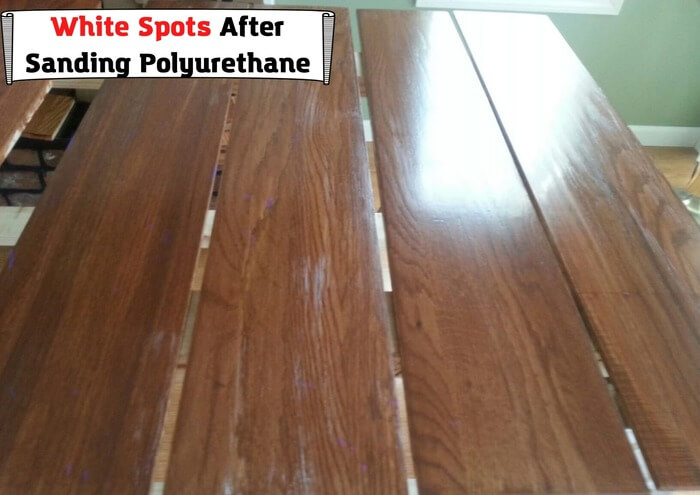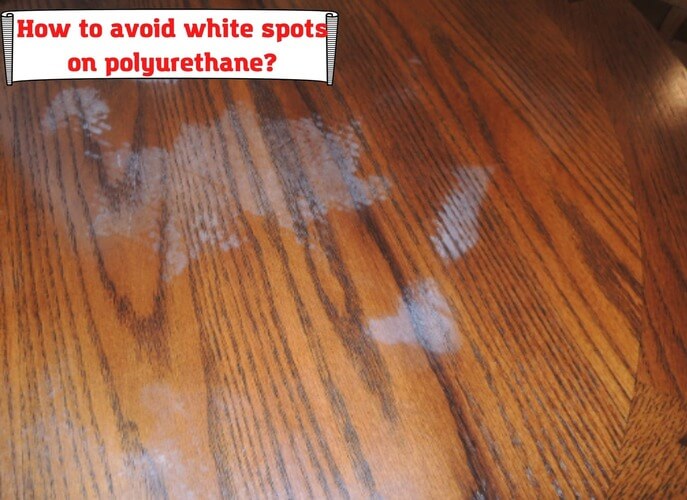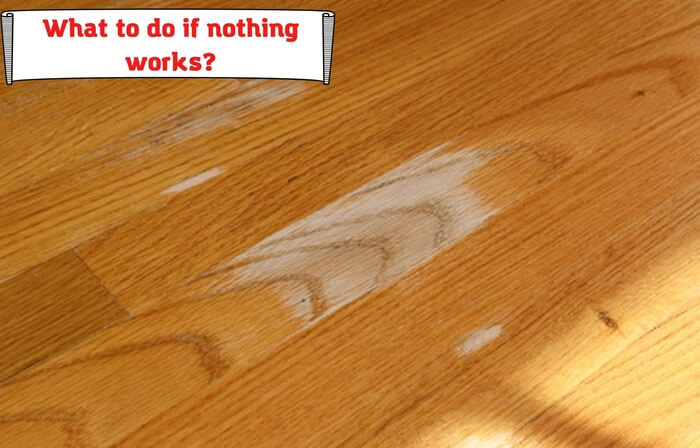
Polyurethane is a very popular material in woodcrafts. People use it much thanks to its practical advantages over any other topcoats in certain cases. If you have successfully applied poly and then found some white spots on it, some bad mistakes were made when applying polyurethane. This finish is really good when applied correctly. But if you make a lot of mistakes, it can bring really bad issues like white spots, peeling off, flaking off, scratches, bad curing, etc.
Today, we’ll focus on white spots and will try to explain why these problems may happen. Usually, fair spots appear when inexperienced woodworkers apply finish and make certain mistakes.
So, in our today’s article, we’ll tell you about such things:
- why excessive moisture can cause white spots;
- what can go wrong when applying polyurethane;
- how to prepare poly before applying to avoid white spots;
- how to understand if your poly is of good quality;
- how to fix it when you see white spots on your wood finish.
Let’s get started!
Excessive moisture when applying poly
Polyurethane should be applied on a dry and cured surface. In this case only, you will get decent results and will be able to achieve the smooth coloring of your finish. Otherwise, different spots may appear which isn’t good for the final design.
We can assure you that in 90% of cases the white spots in your polyurethane finish are formed as a result of moisture buildup. Some water was left on the surface before you applied poly. This moisture buildup can be formed because of different reasons.
Here are some of the most common ones:
- your stain is made of mineral oil that doesn’t dry at all and leaves some moisture under your poly coat;
- you didn’t wait long enough for the stain to dry – please check carefully how much time the chosen stain type needs to completely dry;
- you applied multiple coats of poly too fast without letting it dry before applying the next coat which resulted in water buildup;
- you applied very thick coats of poly that didn’t have a chance to dry completely before the next coats;
- you didn’t make sure that the wood was dry enough when you applied your first coat of poly;
- your water-based poly wasn’t stirred before application which means some parts of it could contain more water than others.
This was a small lecture on what could go wrong. But today we aren’t going to focus on the causes of this because we are pretty sure that you came here to learn how to deal with the problem that has already shown up. This isn’t that easy to answer that question, so we’ll divide it into two main questions you may have right now: how to avoid such white spots; and what to do when you already have them on your finish.
How to avoid white spots on polyurethane?

First, we’ll explain how to avoid white spots when working with wood finishes like poly. The first thing you should remember is that the choice of materials is really important. Many wood craftsmen prefer oil-based polyurethane because it’s more forgiving. But it cures longer and is a little harder to apply. That’s why over time more specialists go for water-based poly that works just as fine as oil-based one.
Then, there are a couple of factors to consider:
- Stir polyurethan before you apply it. When poly stands in a shop for a long time, its components may separate from each other and form kinds of layers. When this happens, you aren’t likely to apply such poly on your wood project and get a good result. Some water may get under one of the coats and become the reason for white spots.
- Use dry instruments. Whatever type of instruments or brushes you use, they should be absolutely dry. Otherwise, some water may get under one of the coats and become a problem in the future.
- Avoid putting polyurethane over mineral oils that don’t dry completely or over any other materials that can still contain some moisture. This will bring to numerous white spots and bad curing of poly.
- Avoid using polyurethane over any stain that hasn’t dried yet. Usually, beginners don’t wipe off the excess stain when they work with wood. Also, they don’t read the instructions of the stain manufacturers and don’t follow their advice.
- Check everything twice when you are about to apply poly. If you make some mistakes, you will need to redo the job and reapply polyurethane spending quite a lot of time on this.
As you see, the main mistakes that bring to white spots in your poly finish are connected with water and moisture. If you are careful enough not to have any water on your wood, the problems will not bother you. But if you make these mistakes, we guarantee that you will need to reapply polyurethane and repair those white spots. Of course, the choice of your materials is important. For example, an expired polyurethane finish may be a reason for white spots on your finish after you apply it.
How to fix white spots on polyurethane?
So, imagine you are sanding one of the final polyurethane coats and suddenly you see a big white spot right in the middle of the facade part of your project. What should you do? Avoid panicking – the worst has already happened. What you need to do now is just fix this with the cheapest and easiest method you may think of.
We are going to provide some ideas of how to get rid of white spots on the polyurethane finish after everything is done.
Sanding down the spot
Well, it isn’t likely to work well in all cases, but you can try. Take 100-grit sandpaper and try to sand carefully the area with the white spot. You can try with 60-grit paper, but then use 200-grit one to hide the damage. If you are lucky enough, you will reveal the coat that is in charge of the water buildup and will repair everything. Then just apply a couple of coats of poly.
But this method won’t work well if it’s a visible part. In this case, you will need to sand down all the parts to take off all poly coats. After that take the rules from the first part of our article and repeat your poly finish application. This will help you fix the spot but will take some time and effort. Of course, you are lucky if the white spot will be located just under the final coat. Then you will only need to sand it a little, reapply some poly, and then apply one final coat of poly over the whole surface.
Using moisture-absorbing tricks
One more trick to use when you have those unpleasant white spots on your finish is to use some absorbers. The legend says that these absorbers can take the water out of your finish. It may happen, but only if your white spot doesn’t sit too deep. For example, you may try applying some mayonnaise over the white spot. It absorbs water when it dries, so it can help with minor spots. But this trick is doubtful. It may be worth trying though because it costs you nothing but time.
Furniture markers – dirty trick
If your white spots are small (the size of a coin, let’s say) and they are located in not a very visible area, you may try special markers. They are called wood markers or furniture markers and they are used for hiding some defects in furniture. These markers come in many different colors, but you should choose a little darker than you originally need to cover that white spot.
You will need a special ritual to successfully use such marker:
- apply the marker over your small white spot without pressing too hard on it;
- let it dry for at least one or two hours and see how it looks;
- apply one thin coat of polyurethane over it to ensure it won’t go off in a month or two;
- let it dry for 24 hours before doing anything else with your project.
This will work well for small white spots, but bigger ones need professional treatment. If this trick doesn’t work fine for your finish, the only thing you are left to do is to sand off all poly you have on your project and to reapply it again using all those tips you may find above in this article.
What if you do everything right and still have white spots on poly?
Here we come to the most interesting part. You may do the job in the right way and follow all instructions, but you may still get those annoying white spots. The reason we can think of is the humidity in the place where you let your project dry. When polyurethane cures, it can absorb some water from the air and it can also cure slowly and hold some moisture under the coat. So the coat has cured, but the water under it didn’t have time to evaporate or dry. This leads to milky spots or shadowing of the polyurethane finish which will make you frustrated.
You shouldn’t just apply another coat of polyurethane over your white spots, this won’t fix the situation. Here’s what you should do:
- You are going to need a heat gun. But we’ve done it successfully with a simple hairdryer, too.
- Just turn on the maximum heat level if you use your hairdryer and heat up the spot where you have those milky shadowing.
- Keep your hairdryer quite close to the spot to make the temperature go up. The water will dry fast.
- Then wait for an hour or two to let the wood cool down and the polyurethane cure once again.
- After that, you can apply the final coat of polyurethane to protect the project.
When you heat up the wood surface, the last coat of poly may come off a little. So you may need to put two coats more after such a procedure. But the result will be amazing – you will get rid of those milky and white spots and will prepare your project for the final coat. The finish will look good without any additional expenses.
What to do if nothing works?

Unfortunately, all these tips don’t always help. Sometimes, after spending some days over your finish you will realize that nothing helps much and those white spots still spoil the design of your project. In this case, only one thing is left: total change of the poly. We can say for sure that the problem is with polyurethane, so you don’t need to sand everything including your primers, stains, etc. All you need to do is to sand polyurethane off the project and reapply it once again.
You may try with one side which is affected by white spots. And then, if the trial is successful, continue with other sides.
But before you start sanding poly off, try all possible ways to fix the situation. We are pretty sure that you may find the way out without sanding your finish down and destroying the wok of your recent days.
Final words
In conclusion, we want to say that those white spots on your polyurethane finish are actually because of water. You may try to remove them using a hairdryer, mayonnaise, partial sanding, and other methods like furniture markers. Also, you may remove them by sanding the whole coating off and applying it once again by paying more attention to curing.
One more thing you will want to know is that the white spots will not disappear by themselves over time. If you decide to continue working under your project without getting rid of those spots, they will spoil the final design of your project. So better use these methods or just redo the finish to get the best result.
- Can You Unmix Paint: Techniques, Consequences, Alternatives - February 23, 2024
- Does Primer Need to be Mixed? Effective Primer Application - February 22, 2024
- How to Make Old Paint Usable Again: Retrieving and Preserving Paint - February 21, 2024



